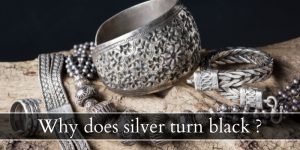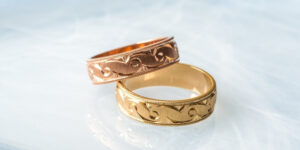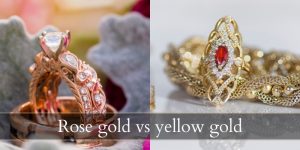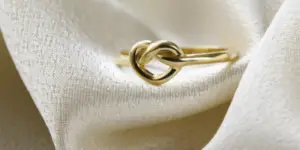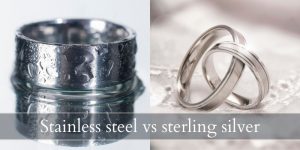If you’re in the market for a good, durable piece of jewelry and you want it white, you’re likely looking at silver and platinum. These are two of the most common precious metals you can get for jewelry, and despite looking very similar, they behave differently down the line.
In time you will notice differences between silver and platinum, and it’s our job to tell you what those differences are. This way you can take a well-researched decision, and get the most bang for your buck. So let’s take a look.
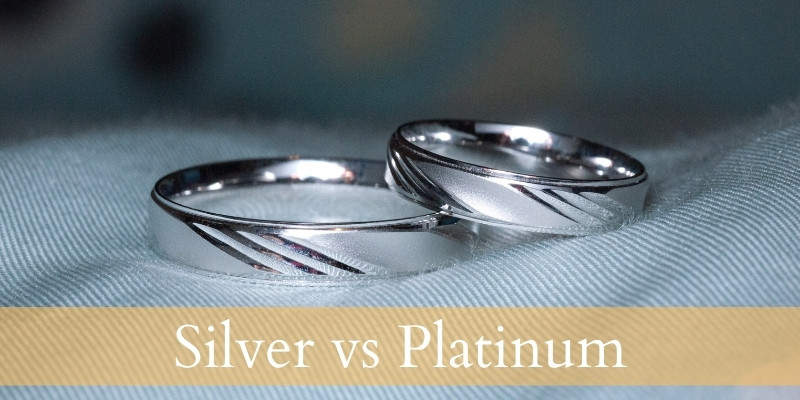
Silver vs platinum
Silver is a softer metal than platinum, and it will scratch and wear down much faster than platinum. There’s also a slight difference in color, with platinum being a bright, silvery white and silver having a grey cast to it.
In terms of money, silver is the most affordable metal of the two and much easier to find in jewelry stores. You need to take a good look at your budget, what you’re willing to pay extra for and what you’re willing to sacrifice.
If your heart is set on a particular piece of jewelry and it can only be done in one metal, maybe it’d help to take a look at a thorough comparison between silver and platinum. First, let’s take a look at what these two metals really are.
What is silver ?
Silver is a precious metal that is found in the Earth’s crust (native metal) and is also a by-product of refining other metals. Its color is native, meaning this is the color it is mined with – a shiny, bright grey that look almost white when polished.
You’ll find silver in many jewelry pieces, or in expensive cutlery (silverware) and even in some industrial settings. However its prime use is in jewelry. Compared to other precious metals, it’s fairly abundant, thus does not cost that much.
What is platinum ?
Platinum is a precious metal with a very rare occurrence in the Earth’s crust. It’s a silvery-white type of metal, and it shines a bright white when polished.
Due to its rarity platinum is considered more expensive than silver, though it’s mainly used in jewelry and not in many industrial settings. It has a high density and does not scratch easily.
Read also: How To Buy Quality Engagement Rings On A Budget
Silver is a more affordable option than platinum
When you’re taking a look at your budget, you’ve surely set an upper limit. If you’re going for platinum, you will hit that upper limit very quickly because platinum is much, much more expensive than silver. In fact, platinum is usually double the price of gold.
Couple this with how much each piece of jewelry will end up weighing, and you’ve got a very expensive piece. That same piece made of silver would be much more affordable.
So if money is an issue, you may want to go for silver.
Platinum wears better, is more durable
In terms of durability, platinum behaves very well. It wears well, does not scratch easily, and keeps its general look. Platinum does develop a slight patina, though it’s not as immediate or obvious as a piece of silver.
Silver is a softer metal, not as durable nor as dense as platinum. This means any piece of jewelry will develop a patina faster, and if you wear it next to something very hard, it will wear down.
For example wearing a silver ring next to a platinum ring means the silver will deform in time and wear down where it keeps bumping against the platinum.
Silver has a grey cast to it, while platinum is brighter
Color differences between silver and platinum are very slight, and you won’t notice the difference until you put both pieces of metal next to each other. And even then, it may not be visible in all lighting.
Where platinum has a nearly-perfect shite shine to it, silver has a slightly darker, grey cast to it. Both shine brightly when polished and work in daylight, and you will only notice the difference if you put them side by side.
Still, the difference is there and it might matter for some.
Platinum does not tarnish easily, silver needs regular polishing
Platinum, being a more durable and less reactive metal, does not tarnish as easily as silver. It does lose its luster in time, as it develops a patina. However it’s very easy take care of, since all you have to do is regularly clean it with a bit of hot, soapy water and then rub it clean.
Silver develops a dark, nearly black hue in different nooks and crannies, and may need regular brushing with a very soft bristled brush. Even plain, flat pieces may develop darker spots, especially where they are tiny corrosions or scratches.
There’s a reason silverware needs to be polished, and it’s a natural part of owning any piece of silver jewelry.
Platinum is hypoallergenic, silver might trigger a reaction
If you know you’ve got a metal allergy, you may want to avoid silver, this is because silver usually contains a bit of copper to make it sturdier. The copper in the silver alloy may trigger a rash or give you a green stain on your skin if you’re very sensitive. Most people are fine wearing silver, but if you know you’ve got sensitive skin it might not be the best option.
Platinum instead has no copper or nickel that could cause an allergic reaction.
What kind of jewelry are you buying ?
When it comes down to it, the type of jewelry is a good indicator for what kind of metal you should go for. Low-wear pieces that you often take off can be bought in silver, since they won’t wear down very fast (because you don’t wear them often).
If you’re buying jewelry that you will wear all day, every day, even shower with it, then you want something more durable. We’re talking about wedding bands, engagement rings, even studs that you don’t want to take off when sleeping.
White gold is a good middle-ground
If you think silver is not good enough, but platinum is simply too expensive, try white gold. This is a type of gold that has been mixed with another metal, a white one such as nickel, platinum, or silver, in order to get you a paler yellow.
Now, how white your white gold is depends on the karats. 18k white gold has more gold, thus more yellow in its final color. 14k gold has less gold in it, just slightly over 50% pure gold. This means you can easily get a very pale yellow ring that could almost pass for white.
Another option, and this is optional, is to get a rhodium plating on your white gold. So you could get an 18k white gold piece coated in rhodium, and you’ve have a perfectly white jewelry piece. It’d be hard to tell the color apart from platinum, and it’d be definitely whiter and brighter than a silver piece.
Keep in mind that gold, like silver, is a softer metal and it will scratch in time. A higher karat piece (like 18k or 24k) is going to wear down faster than a lower karat piece. A lower karat piece is mixed with other metals, which are very likely to have a higher density and be more durable than pure gold.
Whichever metal you end up choosing for your jewelry, keep in mind that the differences are slight, in the end. It more important to find a piece that means a lot to you and one that you really like the look of.

I’m the main author for jewelrymaterialguide.com. I started this site after we did tons of research before our wedding and noticed that there is information about rings, jewelry, and so on that is really hard to find on the internet.

